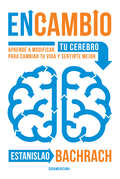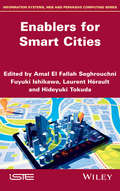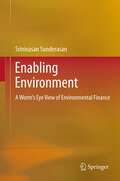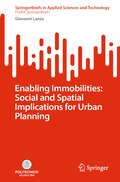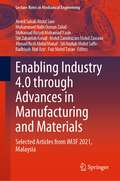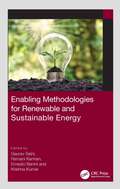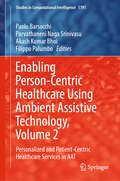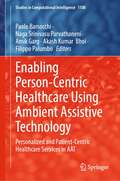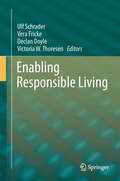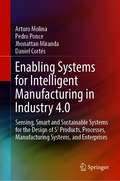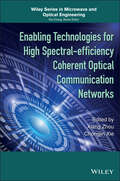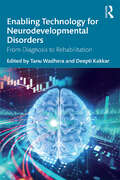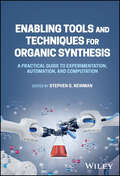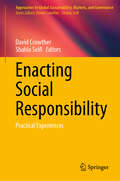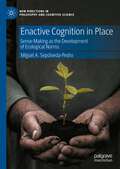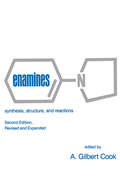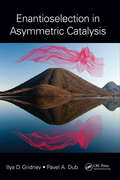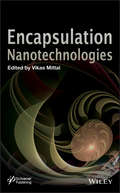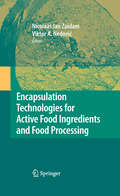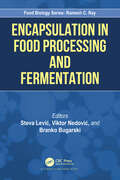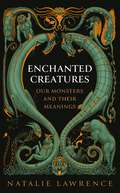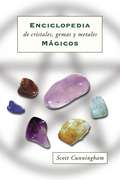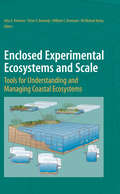- Table View
- List View
EnCambio: Aprendé a modificar tu cerebro para cambiar tu vida y sentirte mejor
by Estanislao Bachrach"Este año cambio de trabajo, empiezo el gimnasio, bajo esos kilitos de más, aprendo un idioma nuevo"Cambiar. Esa es la cuestión.A veces te da tanto miedo no lograrlo que ni siquiera lo intentás. Te decís que sos así, que ya no podés cambiar.Vivís en piloto automático, reaccionando a las diversas situaciones del día a día casi sin pensar. Algunos de estos comportamientos te hacen eficiente, pero otros son detractores de eso que querés hoy para vos.Esto no es casual. No sos vos, es tu cerebro. Estas reaccionesautomáticas son determinadas por patrones cerebrales que vasconstruyendo a lo largo de tu vida.EnCambio te va a permitir alumbrar los procesos por los cuales pensás, sentís y te comportás de determinada manera, y así dejar atrás aquellos hábitos y conductas que ya no te sirven. El objetivo es que aprendas el potencial que tiene tu cerebro para cambiar y la capacidad que tenés vos para modificarlo.En este libro encontrarás la forma de conocerte mejor, paso fundamental para lograr un mayor bienestar, y las herramientas para que puedas cambiar pensamientos, emociones y acciones que entorpecen la vida que querés, con el fin de conseguir objetivos a largo plazo, personales y profesionales.Con ÁgilMente, Estanislao Bachrach llevó el conocimiento científico del cerebro a la vida cotidiana de miles de lectores. EnCambio lo instala definitivamente como el gran divulgador de la biología de nuestro órgano más complejo y preciado.
Enablers for Smart Cities
by Fuyuki Ishikawa Hideyuki Tokuda Amal El Seghrouchni Laurent HéraultSmart cities are a new vision for urban development. They integrate information and communication technology infrastructures - in the domains of artificial intelligence, distributed and cloud computing, and sensor networks - into a city, to facilitate quality of life for its citizens and sustainable growth. This book explores various concepts for the development of these new technologies (including agent-oriented programming, broadband infrastructures, wireless sensor networks, Internet-based networked applications, open data and open platforms), and how they can provide smart services and enablers in a range of public domains. The most significant research, both established and emerging, is brought together to enable academics and practitioners to investigate the possibilities of smart cities, and to generate the knowledge and solutions required to develop and maintain them.
Enabling Environment
by Srinivasan SunderasanEnabling Environment is as real as it gets. The global commons are jointly owned and their inhabitants are jointly obligated to ensure their preservation. In the face of protracted negotiations, convoluted documentation, discord, and incessant bickering among scientists, activists, pressure groups of various hues, politicians and negotiators, very often the people on the ground are ignored or taken for granted. In the meantime, life meanders along. It is these 'everyday individuals' who make consumption-related choices on their lifestyles, travel or on preferring certain products or services over others. Enabling Environment puts the individual front and center. Ecosystem services need to be recognized, appropriately priced and the costs allocated to the agents concerned. Enabling Environment is about defining economic and non-economic incentive structures and utilizing them to arrive at pro-environmental outcomes. This collection of articles illustrates the use of existing social, economic and regulatory structures, and the financial architecture and instruments, suitably modified or extended, to help internalize the environmental externality.
Enabling Immobilities: Social and Spatial Implications for Urban Planning (SpringerBriefs in Applied Sciences and Technology)
by Giovanni LanzaThis book presents a novel perspective on immobility, a topic often overlooked in urban planning and transport studies. It argues that conceptualizing, measuring, and analyzing the diverse forms in which individual immobilities manifest can provide crucial insights for designing more inclusive and sustainable planning policies. Immobility is here framed as a relative condition, where individuals experience reduced movement across time and space compared to others. While mobility is often seen as essential for social inclusion, this book challenges the notion that immobility is inherently negative. Instead, it positions immobility as not only the result of specific personal or spatial constraints but also as a reversible, voluntary choice to reduce daily travel. This choice can be influenced by the level of accessibility and proximity to valued spatial opportunities and can yield significant socio-environmental benefits. The book introduces an innovative framework that integrates immobility into urban planning theory and practice. Through case studies, it addresses four main operational challenges to foster a deeper understanding of immobility’s social and spatial implications: the measurement of immobility, the analysis of spatial conditions that facilitate chosen immobility, the exploration of the lived experiences of immobility, and the examination of planning policies that can promote reversible immobility to advance social inclusion and sustainability. By examining immobility in both its constrained and reversible forms, the book contributes to broader debates on how to achieve inclusion, sustainability, and accessibility through planning.
Enabling Industry 4.0 through Advances in Manufacturing and Materials: Selected Articles from iM3F 2021, Malaysia (Lecture Notes in Mechanical Engineering)
by Muhammed Nafis Osman Zahid Amiril Sahab Abdul Sani Mohamad Rusydi Mohamad Yasin Faiz Mohd Turan Siti Zubaidah Ismail Mohd Zairulnizam Mohd Zawawi Ahmad Rosli Abdul Manaf Siti Nadiah Mohd Saffe Radhiyah Abd AzizThis book presents part of the proceedings of the Manufacturing and Materials track of the iM3F 2021 conference held in Malaysia. This collection of articles deliberates on the key challenges and trends related to manufacturing as well as materials engineering and technology in setting the stage for the world in embracing the Fourth Industrial Revolution. It presents recent findings with regard to manufacturing and materials that are pertinent toward the realizations and ultimately the embodiment of Industry 4.0, with contributions from both industry and academia.
Enabling Methodologies for Renewable and Sustainable Energy
by Krishna Kumar Gaurav Saini Ramani Kannan Ernesto BeniniThis book aims to provide practical aspects of, and an introduction to, the applications of various technological advancement tools, such as AI, machine learning to design, big data, cloud computing, and IoT, to model, characterize, optimize, forecast, and do performance prediction of renewable energy exploitation. It further discusses new avenues for energy sources such as hydrogen energy generation and energy storage technologies including existing policies and case studies for a better understanding of renewable energy generation. Features: Covers technologies considered to explore, predict, and perform operation and maintenance of renewable energy sources. Aids in the design and use of renewable energy sources, including the application of artificial intelligence in a real-time environment. Includes IoT, cloud computing, big data, smart grid, and different optimization techniques for resource forecasting, installation, operation, and optimization of energy. Discusses the principle of integration/hybridization of renewable energy sources along with their optimization based on energy requirements. Reviews the concepts and challenges involved in the implementation of smart grids. This book is aimed at researchers and graduate students in renewable energy engineering, computer and mechanical engineering, novel technologies, and intelligent systems.
Enabling Person-Centric Healthcare Using Ambient Assistive Technology, Volume 2: Personalized and Patient-Centric Healthcare Services in AAT (Studies in Computational Intelligence #1191)
by Akash Kumar Bhoi Paolo Barsocchi Filippo Palumbo Parvathaneni Naga SrinivasuThis book focuses more on the transformative impact of person-centric health care, where it explores cutting-edge advancements in integrating artificial intelligence and machine learning to deliver personalized and efficient care. Key topics include the application of predictive models for critical health conditions such as brain stroke, lung cancer, diabetes, and Alzheimer's, as well as the integration of secure frameworks to protect sensitive patient data. The book also covers advanced techniques for recognizing human activities in ambient environments, optimizing patient data clustering, and evaluating deep learning methods for unique use cases like yoga pose classification and resource optimization in smart healthcare. Designed for healthcare professionals, researchers, data scientists, and technologists, this book presents a harmonious blend of technical insights and practical applications, emphasizing person-centric approaches. By focusing on multi-disease prediction, assistive technologies, and enhanced emergency management, this book serves as a vital resource for innovating healthcare delivery in smart environments.
Enabling Person-Centric Healthcare Using Ambient Assistive Technology: Personalized and Patient-Centric Healthcare Services in AAT (Studies in Computational Intelligence #1108)
by Akash Kumar Bhoi Amik Garg Paolo Barsocchi Naga Srinivasu Parvathaneni Filippo PalumboThis book experiences the future of patient-centered healthcare and dives into the latest advancements and transformative technologies that are revolutionizing the well-being of individuals around the globe. The readers can join authors on an engaging journey as the authors explore the captivating realm of ambient assisted living and unlock its immense potential for improving healthcare outcomes. This book goes beyond mere exploration; it invites readers to embark on a voyage of discovery as authors unveil the outcomes of groundbreaking research ideas. With a diverse range of applications, from deep learning in healthcare to cutting-edge models, the authors offer a comprehensive view of the opportunities and challenges that lie ahead. Whether you're a healthcare professional, an academic seeking the latest insights, or a researcher delving into the realms of ambient assistive technology, biomedical engineering, or computational intelligence, this book is an invaluable resource. Additionally, postgraduate students pursuing data engineering systems find it to be an essential guide. Each chapter stands independently, providing a comprehensive overview of problem formulation and its tangible outcomes. The readers can immerse themselves in the world of patient-centered healthcare today and become part of the forefront of innovation.
Enabling Responsible Living
by Declan Doyle Ulf Schrader Vera Fricke Victoria W. ThoresenThe book focuses on responsible living as the individual's contribution to sustainable development. We believe that sustainable development can only be achieved if individual freedom and responsibilities are balanced on a high level while taking social, ecological and economic needs into account. A crucial element to achieve this is to integrate different perspectives of stakeholders and co-create a joined approach through partnerships. While partnerships develop new opportunities for the stakeholders involved they also require a readiness for mutual understanding, respect and courage to co-create.
Enabling Systems for Intelligent Manufacturing in Industry 4.0: Sensing, Smart and Sustainable Systems for the Design of S3 Products, Processes, Manufacturing Systems, and Enterprises
by Arturo Molina Pedro Ponce Jhonattan Miranda Daniel CortésThis book introduces the concept of sensing, smart and sustainable systems (S3 systems) to support the design and redesign of products, services, business and manufacturing processes, manufacturing systems, and enterprises. The concept of S3 systems theory is introduced and explained in detail to support designers and engineers in their development task. This approach is embraced in the implementation of emergent Information and communication technologies and artificial intelligence techniques. The text helps the reader to understand the relationship between intelligent manufacturing, S3 systems and Industry 4.0. It presents a review of current approaches to design and development of technology-based products. Finally, it enlarges on the sensing, smart and sustainable systems theory to give examples of S3 systems as case studies.
Enabling Technologies for High Spectral-efficiency Coherent Optical Communication Networks
by Xiang Zhou Chongjin XiePresents the technological advancements that enable high spectral-efficiency and high-capacity fiber-optic communication systems and networks This book examines key technology advances in high spectral-efficiency fiber-optic communication systems and networks, enabled by the use of coherent detection and digital signal processing (DSP). The first of this book's 16 chapters is a detailed introduction. Chapter 2 reviews the modulation formats, while Chapter 3 focuses on detection and error correction technologies for coherent optical communication systems. Chapters 4 and 5 are devoted to Nyquist-WDM and orthogonal frequency-division multiplexing (OFDM). In chapter 6, polarization and nonlinear impairments in coherent optical communication systems are discussed. The fiber nonlinear effects in a non-dispersion-managed system are covered in chapter 7. Chapter 8 describes linear impairment equalization and Chapter 9 discusses various nonlinear mitigation techniques. Signal synchronization is covered in Chapters 10 and 11. Chapter 12 describes the main constraints put on the DSP algorithms by the hardware structure. Chapter 13 addresses the fundamental concepts and recent progress of photonic integration. Optical performance monitoring and elastic optical network technology are the subjects of Chapters 14 and 15. Finally, Chapter 16 discusses spatial-division multiplexing and MIMO processing technology, a potential solution to solve the capacity limit of single-mode fibers. * Contains basic theories and up-to-date technology advancements in each chapter * Describes how capacity-approaching coding schemes based on low-density parity check (LDPC) and spatially coupled LDPC codes can be constructed by combining iterative demodulation and decoding * Demonstrates that fiber nonlinearities can be accurately described by some analytical models, such as GN-EGN model * Presents impairment equalization and mitigation techniques Enabling Technologies for High Spectral-efficiency Coherent Optical Communication Networks is a reference for researchers, engineers, and graduate students. Xiang Zhou is a Tech Lead within Google Platform Advanced Technology. Before joining Google, he was with AT&T Labs, conducting research on various aspects of optical transmission and photonics networking technologies. Dr. Zhou is an OSA fellow and an associate editor for Optics Express. He has extensive publications in the field of optical communications. Chongjin Xie is a senior director at Ali Infrastructure Service, Alibaba Group. Before joining Alibaba Group, he was a Distinguished Member of Technical Staff at Bell Labs, Alcatel-Lucent. Dr. Xie is a fellow of OSA and senior member of IEEE. He is an associate editor of the Journal of Lightwave Technology and has served in various conference committees.
Enabling Technology for Neurodevelopmental Disorders: From Diagnosis to Rehabilitation
by Tanu WadheraThis cutting-edge volume explores how technological tools can be designed, engineered and implemented to assess and support individuals with neurodevelopmental disorders from diagnosis through to rehabilitation. Tanu Wadhera and Deepti Kakkar and their expert contributors focus on technological tools as equalizers in Neurodevelopmental disorders (NDDs) at every stage, the importance of demand-specific design, and how we can best engineer and deploy both invasive and non-invasive individual-centered approaches that support and connect individuals. Considering the perspectives of patients, clinicians and technologists, it explores key topics including design and evaluation of platforms for tech-tools, automated diagnosis, brain imaging techniques, tech-diagnostic frameworks with AI and machine learning, sensing technology, smart brain prosthetics, gamification, alternative communication devices, and education tools and interactive toys. Outlining future challenges for research, Enabling Technology for Neurodevelopmental Disorders is useful for scholars and professionals in psychology, technology, engineering and medicine concerned with design, development and evaluation of a range of assistive technological tools.
Enabling Tools and Techniques for Organic Synthesis: A Practical Guide to Experimentation, Automation, and Computation
by Stephen G. NewmanENABLING TOOLS AND TECHNIQUES FOR ORGANIC SYNTHESIS Provides the practical knowledge of how new technologies impact organic synthesis, enabling the reader to understand literature, evaluate different techniques, and solve synthetic challenges In recent years, new technologies have impacted organic chemistry to the point that they are no longer the sole domain of dedicated specialists. Computational chemistry, for example, can now be used by organic chemists to help predict outcomes, understand selectivity, and decipher mechanisms. To be prepared to solve various synthetic problems, it is increasingly important for chemists to familiarize themselves with a range of current and emerging tools and techniques. Enabling Tools and Techniques for Organic Synthesis: A Practical Guide to Experimentation, Automation, and Computation provides a broad overview of contemporary research and new technologies applied to organic synthesis. Detailed chapters, written by a team of experts from academia and industry, describe different state-of-the-art techniques such as computer-assisted retrosynthesis, spectroscopy prediction with computational chemistry, high throughput experimentation for reaction screening, and optimization using Design of Experiments (DoE). Emphasizing real-world practicality, the book includes chapters on programming for synthetic chemists, machine learning (ML) in chemical synthesis, concepts and applications of computational chemistry, and more. Highlights the most recent methods in organic synthesis and describes how to employ these techniques in a reader’s own research Familiarizes readers with the application of computational chemistry and automation technology in organic synthesis Introduces synthetic chemists to electrochemistry, photochemistry, and flow chemistry Helps readers comprehend the literature, assess the strengths and limitations of each technique, and apply those tools to solve synthetic challenges Provides case studies and guided examples with graphical illustrations in each chapter Enabling Tools and Techniques for Organic Synthesis: A Practical Guide to Experimentation, Automation, and Computation is an invaluable reference for scientists needing an up-to-date introduction to new tools, graduate students wanting to expand their organic chemistry skills, and instructors teaching courses in advanced techniques for organic synthesis.
Enacting Social Responsibility: Practical Experiences (Approaches to Global Sustainability, Markets, and Governance)
by David Crowther Shahla SeifiThis book explores the pervasive nature of socially responsible behavior, which has evolved beyond Corporate Social Responsibility (CSR) to become an integral part of all organizational activities and investments. It presents how socially responsible decision-making is now embedded within the core operations of organizations globally. Despite the widespread recognition of its importance, there remains a significant gap in understanding the practical effects of such behavior. This book aims to bridge that gap by providing a comprehensive analysis of the real-world impacts of social responsibility. Taking a global perspective, the book investigates the practical outcomes of socially responsible actions across various countries and sectors. It explores how organizations worldwide implement and benefit from these practices, offering a rich tapestry of observations and insights. By examining a diverse range of fields, the book presents a holistic view of the effects of socially responsible behavior, highlighting both successes and challenges. Through its detailed analysis and global scope, this book offers valuable contributions to the ongoing discourse on social responsibility. It provides readers with a deeper understanding of how socially responsible practices are applied in different contexts and their tangible impacts. Whether you are a scholar, practitioner, or policymaker, this book serves as an essential resource for anyone interested in the practical implications of social responsibility in today’s interconnected world.
Enactive Cognition in Place: Sense-Making as the Development of Ecological Norms (New Directions in Philosophy and Cognitive Science)
by Miguel A. Sepúlveda-PedroThis book aims to enrich our understanding of the role the environment plays in processes of life and cognition, from the perspective of enactive cognitive science. Miguel A. Sepúlveda-Pedro offers an unprecedented interpretation of the central claims of the enactive approach to cognition, supported by contemporary works of ecological psychology and phenomenology. The enactive approach conceives cognition as sense-making, a phenomenon emerging from the organizational nature of the living body that evolves in human beings through sensorimotor, intercorporeal, and linguistic interactions with the environment. From this standpoint, Sepúlveda-Pedro suggests incorporating three new theses into the theoretical body of the enactive approach: sense-making and cognition fundamentally consist of processes of norm development; the environment, cognitive agents actually interact with, is an active ecological field enacted in their historical past; and sense-making occurs in a domain consisting of multiple normative dimensions that the author names enactive place.
Enamines: Synthesis: Structure, and Reactions, Second Edition,
by A. Gilbert CookReviewing and correlating in detail the synthetic, mechanistic, and physical properties ofenamines, this reference features an extensive discussion of all enamine literature ...numerous practical examples of synthetic enamine applications ... new information onoxidation-reduction reactions of enamines ... numerous tables and schemes that givefast, easy access to a wealth of useful data .. . and improved coordination among contributingauthors to reduce duplication and overlap.Thoroughly updating the original edition, Enamines, Second Edition contains over2,400 bibliographic citations that help researchers investigate particular subjects ingreat.er depth. It comprises an authoritative source for organic, synthetic, physical, andnatural products chemists in academe, industry, or government, as well as for advancedgraduate students in these disciplines.
Enantioselection in Asymmetric Catalysis (4x45)
by Ilya D. Gridnev Pavel A. DubThe field of asymmetric catalysis is currently one of the hottest areas in chemistry. This unique book focuses on the mechanism of enantioselectivity in asymmetric catalysis, rather than asymmetric catalysis from the synthetic view. It describes reliable, experimentally and computationally supported mechanisms, and discusses the danger of so-called "plausible" or "accepted" mechanisms leading to wrong conclusions. It draws parallels to enzymatic catalysis in biochemistry, and examines in detail the physico-chemical aspects of enantioselective catalysis.
Enantioselective Organocatalyzed Reactions I
by Rainer MahrwaldOrganocatalyzed Reactions I and II presents a timely summary of organocatalysed reactions including: a) Enantioselective C-C bond formation processes e.g. Michael-addition, Mannich-reaction, Hydrocyanation (Strecker-reaction), aldol reaction, allylation, cycloadditions, aza-Diels-Alder reactions, benzoin condensation, Stetter reaction, conjugative Umpolung, asymmetric Friedel-Crafts reactions; b) Asymmetric enantioselective reduction processes e.g. Reductive amination of aldehydes or ketones, asymmetric transfer hydrogenation; c) Asymmetric enantioselective oxidation processes; d) Asymmetric epoxidation, Bayer-Villiger oxidation; e) Enantioselective a-functionalization; f) A-alkylation of ketones, a-halogenation and a-oxidation of carbonyl compounds.
Encapsulation Nanotechnologies
by Vikas MittalThis unique and comprehensive book covers all the recent physical, chemical, and mechanical advancements in encapsulation nanotechnologies.Encapsulation is prevalent in the evolutionary processes of nature, where nature protects the materials from the environment by engulfing them in a suitable shell. These natural processes are well known and have been adopted and applied in the pharmaceutical, food, agricultural, and cosmetics industries.In recent years, because of the increased understanding of the material properties and behaviors at nanoscale, research in the encapsulation field has also moved to the generation of nanocapsules, nanocontainers, and other nano devices. One such example is the generation of self-healing nanocontainers holding corrosion inhibitors that can be used in anti-corrosion coatings. The processes used to generate such capsules have also undergone significant developments. Various technologies based on chemical, physical, and physico-chemical synthesis methods have been developed and applied successfully to generate encapsulated materials.Because of the increasing potential and value of the new nanotechnologies and products being used in a large number of commercial processes, the need for compiling one comprehensive volume comprising the recent technological advancements is also correspondingly timely and significant. This volume not only introduces the subject of encapsulation and nanotechnologies to scientists new to the field, but also serves as a reference for experts already working in this area.Encapsulation Nanotechnologies details in part:The copper encapsulation of carbon nanotubesVarious aspects of the application of fluid-bed technology for the coating and encapsulation processesThe use of the electrospinning technique for encapsulationThe concept of microencapsulation by interfacial polymerizationOverviews of encapsulation technologies for organic thin-film transistors (OTFTs), polymer capsule technology, the use of supercritical fluids (such as carbon dioxide), iCVD process for large-scale applications in hybrid gas barriersReadershipEncapsulation Nanotechnologiesis of prime interest to a wide range of materials scientists and engineers, both in industry and academia.
Encapsulation Technologies for Active Food Ingredients and Food Processing
by N. J. Zuidam Viktor NedovicConsumers prefer food products that are tasty, healthy, and convenient. Encapsulation is an important way to meet these demands by delivering food ingredients at the right time and right place. For example, encapsulates may allow flavor retention, mask bad tasting or bad smelling components, stabilize food ingredients, and increase their bioavailability. Encapsulation may also be used to immobilize cells or enzymes in the production of food materials or products, such as fermentation or metabolite production. This book provides a detailed overview of the encapsulation technologies available for use in food products, food processing, and food production. The book aims to inform those who work in academia or R&D about both the delivery of food compounds via encapsulation and food processing using immobilized cells or enzymes. The structure of the book is according to the use of encapsulates for a specific application. Emphasis is placed on strategy, since encapsulation technologies may change. Most chapters include application possibilities of the encapsulation technologies in specific food products or processes. The first part of the book reviews general technologies, food-grade materials, and characterization methods for encapsulates. The second part discusses encapsulates of active ingredients (e.g., aroma, fish oil, minerals, vitamins, peptides, proteins, probiotics) for specific food applications. The last part describes immobilization technologies of cells and enzymes for use within food fermentation processes (e.g., beer, wine, dairy, meat), and food production (e.g., sugar conversion, production of organic acids or amino acids, hydrolysis of triglycerides). Edited by two leading experts in the field, Encapsulation Technologies for Food Active Ingredients and Food Processing will be a valuable reference source for those working in the academia or food industry. The editors work in both industry or academia, and they have brought together in this book contributions from both fields.
Encapsulation in Food Processing and Fermentation (Food Biology Series)
by Steva LevićFood technology has adopted new principles and practices that are rapidly changing the food sector. New foods are now available under more uniform standards and better quality control. Globalised food market offers opportunities for manufacturers to increase production and profit, and at the same time, consumers benefit from the choice of food products like never before. All this is possible only because of the innovations in the food sector. One of such innovations is encapsulation technology, which aims to preserve food quality, enhance the sensorial properties of food and increase the efficiency in food processing. This book discusses the uses of encapsulation technology in food practices and conventional processes and also highlights new directions in food processing. In the introductory chapters’ review of encapsulation technologies, carrier materials and criteria for their selection, analytical methods for characterisation of encapsulated products and some aspects of product design and process optimisation. The most important achievements of encapsulation technology in the food sector are reviewed in the later chapters related to encapsulation of food ingredients, food biocatalysts and examples of usage of encapsulated active ingredients in the dairy and meat industry, beverage production, etc. In addition, the implementation of nanotechnology in the food sector is reviewed, emphasizing the most important materials and technologies for the production of nanoencapsulates. The book is a valuable source of information on encapsulation technology, for academia and industry, especially the food sector, with the aim of enhancing knowledge transfer.
Enchanted Creatures: Our Monsters and Their Meanings
by Natalie LawrenceThe hydra rears its many heads in a flurry of teeth and poisonous fumes. The cyborg lays waste to humanity with a ruthless, expressionless stare.From ancient mythology to modern science fiction, we have had to confront the monsters that lurk in the depths of our collective imagination. They embody our anxieties and our irrational terrors, giving form to what we don't wish to know or understand. For millennia, monsters have helped us to manage the extraordinary complexity of our minds and to deal with the challenges of being human.In Enchanted Creatures, Natalie Lawrence delves into 15,000 years of imaginary beasts and uncovers the other-worldly natural history that has evolved with our deepest fears and fascinations. Join Lawrence on a tour of prehistoric cave monsters, serpentine hybrids, deep-sea leviathans and fire-breathing Kaiju. Discover how this monstrous menagerie has shaped our minds, our societies and how we see our place in nature.
Enchanted by Daphne: The Life of an Evolutionary Naturalist
by Peter R. GrantThe extraordinary life story of the celebrated naturalist who transformed our understanding of evolutionEnchanted by Daphne is legendary ecologist Peter Grant’s personal account of his remarkable life and career. In this revelatory book, Grant takes readers from his childhood in World War II–era Britain to his ongoing research today in the Galápagos archipelago, vividly describing what it's like to do fieldwork in one of the most magnificent yet inhospitable places on Earth. This is also the story of two brilliant and courageous biologists raising a family together while balancing the demands of professional lives that would take them to the far corners of the globe.In 1973, Grant and his wife, Rosemary, embarked on a journey that would fundamentally change how we think about evolution. Over the next four decades, they visited the Galápagos every year to observe Darwin’s famous finches on the remote, uninhabited island of Daphne Major. Documenting how eighteen species have diversified from a single ancestral species, they demonstrated that we could actually see and measure evolution in a natural setting. Grant recounts the blind alleys and breathtaking triumphs of this historic research as he and Rosemary followed in Darwin’s footsteps—and ushered in a new era in ecology.A wonderfully absorbing portrait of a life in science, Enchanted by Daphne is an unforgettable chronicle of the travels and discoveries of one of the world’s most influential naturalists.
Enclosed Experimental Ecosystems and Scale
by W. Michael Kemp John E. Petersen William C. Dennison Victor S. KennedyEnclosed ecosystem experiments have gained in popularity as research tools in ecological science, particularly in the study of coastal aquatic environments. These systems provide scientists with a degree of experimental control that is not achievable through field experiments. Yet to date, techniques for systematically extrapolating results from small-scale experimental ecosystems to larger, deeper, more open, more biologically diverse, and more heterogeneous ecosystems in nature have not been well developed. Likewise, researchers have lacked methods for comparing and extrapolating information among natural ecosystems that differ in scale. Enclosed Experimental Ecosystems and Scale: Tools for Understanding and Managing Coastal Ecosystems provides scientists, managers, and policy makers with an introduction to what has been termed the "problem of scale", and presents information that will allow for improved design and interpretation of enclosed experimental aquatic ecosystems. The book integrates the results of a 10-year research project involving a multi-disciplinary team of scientists and students to explore scale-related questions in a variety of coastal habitats. Anticipating use as a reference, the book has been designed so that individual sections and individual pages can function as stand alone units.
